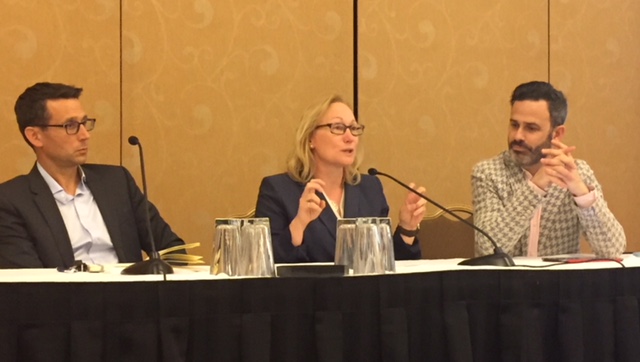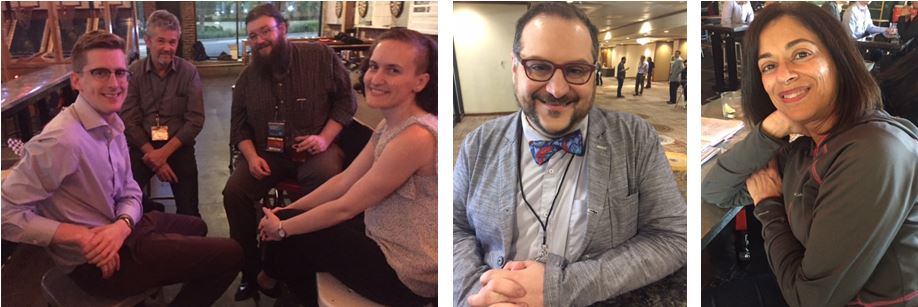From Cloud to Curb; Smart City as Movement
In May of 2018, ITE’s QUAD Conference was held in Portland, Oregon. This Pacific Northwest annual transportation conference represents transportation professionals from British Columbia, Washington, Oregon and beyond. The Greater Vancouver, Vancouver Island, Washington State, and Oregon State Sections each take turns hosting. A packed line up comprised of three days of learning, sharing, conversation, a fantastic Verizon sponsored happy hour and even a raffle. This post an overview of the ITE Quad luncheon keynote with a focus on the Smart City landscape.
In its third iteration Smart Cities still quite new in a professional community that has historically produced plans for regions on a 20 to 30 year time table. A single afternoon not much time to contain the scope of innovation, experiments, new partnerships, investment and energy this movement represents. Suggesting this as a movement, in that we clearly have a group of people working together to advance their shared ideas around infrastructure, technology and outcomes to optimize cities and citizens for generations to come. In ways that didn’t exist thirty, twenty, ten or even five years ago.

The afternoon’s luncheon keynote “Evolving the Urban Fabric” offered a well balanced mix. Led by Gabe Klein, an entrepreneur, investor and former government official and author of Start-Up City. Klein was joined by newly elected (by a 84% majority) Lynn Peterson, Metro Council President with two decades of experience working for two governors, reforming agencies and successfully raising billions of dollars for infrastructure initiatives (e.g. roads, rail, transit, affordable housing). Sean Harrington, Vice President of City Solutions at Verizon leads product management, engineering and operations. The day of the keynote, Verizon had just launched their new 5 G service, with a successful pilot in Sacramento. Timely for a discussion on the topic of Smart Cities, the afternoon sessions guided by three expert practitioners leading a range of private, public and technology-driven city, region and nation-wide transportation innovation
Future Proofing, Pace & the Public Private Proposition
As Gabe Klein set up the conversation, he confessed being a “fan of solving for the root cause problem rather than a symptom of the symptom of the problem.” Klein sees it as when “doing something for the greater good. A lot easier for the private sector to work with government when they have that focus. I believe that both government and private sector should be focused on return on investment not just the private sector. Are we doing something that is best for tax payer? As low cost and high return as possible?
The balance of private, public partnership was a thread throughout the conversation. As well as methods, examples and cautions in what we gain or lose by not innovating in delivery of integrated state, region or city-wide infrastructure efforts. For example, there were numerous comments that noted procurement and the pace of government decision making as a historical barrier to innovation. The nature of silo’d expertise, a legacy artifact of industry simply working in their respective area of focus. Noting challenges to collective gains when true cross-department cross-disciplinary initiatives are still rare, Peterson kicked off the discussion with a compelling way of thinking about this:
“Assumptions about how to do business for future is still set in past ways of doing business, if that is the case our outcomes are outdated at this point. Because we are not talking about:
(A) What people actually want out of their transport system, if we’re only talking about “level service,” we’re just not doing it, that’s not what’s going to catch people’s attention to get them to actually invest in the public side of this.
And (B) we need to talk about the performance metrics that we’re trying to accomplish, the values and the performance metrics, are way more vast and you all have a huge effect on them…”
Harrington came at this from the perspective of a technology leader from the product delivery side, working in a new way with regional and municipal players. “The challenge we all face,” Harrington pointed out in a “combination of private – public sector, is the pace of innovation and the innovation cycle — the pace has accelerated. Take any one element, open source software, block chain technology, technology elements such as cloud computing… Advancements on all sides, accelerating at an exponential rate. It’s not linear, it’s all evolving so fast, tech and business models evolving so fast… from a city or agency perspective we get that. Finding creative ways that procurement, to work together, to try to match up with pace of innovation. Sacramento P 3 – 5 G – DOT commissioner, local control is key. But having to deal with each municipality to build out the over arching technology, a challenge across national – regional – local levels…”

Partnership, Alignment & Reset on Risk
Gabe Klein responded and guided thinking with both statements and questions, looking at it as “human centered design,” asking “are we focused on what’s really good for people? The US is very focused on individual freedom wanting to get as fast as they can to their plane… when say in Asia there is more focus on a greater societal good — to focus on human beings in context of what’s good for society, are we really solving the problem or trying to solve for a downstream problem?”
With today’s capabilities, tackling infrastructure of regions and cities as a system, we see new business models emerging rapidly. With an equal degree and pace of complexity, as these new systems experiment, iterate and evolve. The strategic value in allowing the marketplace to drive innovation is indisputable. But within this, as government and the private sector find their way in these new partnerships, is the essential understanding of risk. Peterson encouraged that when getting down to the “bottom line in the public sector and the private sector up until now, combined, we have not evaluated risk properly. Until we evaluate risk appropriately and we understand, where the risks lie, we can’t get out of the box that we’re in. If we don’t change the actual processes and structures, to work with the private industry in the way we need to… until we understand the risk we take BY NOT CHANGING is greater than doing things the same ol’ same old way.”
Leveraging capacity, companies like Verizon may provide an entirely new era of corporate contribution. For full disclosure, Verizon was one of the key sponsors of this event. As were numerous others. While there is an obvious tension where corporations drive community or city wide innovation, such as Tesla or Google, in the same communities they aim to expand business. It is also key to observe good corporate players in markets where these very entities bring tremendous value of infrastructure, resources, expertise and capabilities. Verizon long known for being a TelCom giant, is breaking new ground piloting technology and partnerships. For example Verizon’s work in the City of Sacramento as the first pilot for a 5 G enabled city, are readily evolving their market focus in this process. Harrington reflected on the Sacramento pilot, as he explained:
“This means we need to be able to come in and say, here’s the benefit to you – the city or & your agency and what we’re trying to accomplish with the deployment of technology and by the way, we also have solutions that are designed to help solve your traffic challenges, public safety challenges, lighting and efficiency challenges, and why don’t we talk about what you’re trying to accomplish, what your biggest challenges are and what we’re prepared to do to investment in your city, and find the right combination of benefits that move the entire city forward…
That the way we’re approaching it, like we did in Sacramento, truly coming to the city from the perspective of partnership. In how we are helping to solve for the challenges of public/private partnerships – in the example of Sacramento, we’re putting in wifi at parks and community centers, we’re putting in traffic management solutions at different intersections , providing traffic data services…”

Keeping the Human in the Loop: Context
In the era of big data, the conversation yielded a healthy balance touching on topics of congestion pricing, machine learning, equity, flexibility, Vision Zero – to name a few. And probably most human, at the center of this, we simply “don’t know what we don’t know.” Makes planning for the future equal parts preparation, observation and natural market gyration. And not getting in our way, to enable and allow for innovation, while monitoring and ensuring value or benefit to the public guides thinking and delivery. Harrington talked about this in order of magnitude:
“In wireless industry as you go to 5 G in an order of magnitude greater in bandwidth and reduction in latency, you also have a greater need for deployment of density of radios, so 300,000 roughly macro-cell sites around US is going to be an order of magnitude larger number of radios that have to be deployed, in order to enable this next wave of technology. Which is going to enable niche applications we don’t even know today. In 2007 when Verizon and others were investing heavily in LTE – it’s not that they knew the iPhone was going to come out and be such a big hit and lead to social and mobile. People even in 2012 didn’t fully understand it…”
Peterson added the perspective of serving “as a regional government – we need to not only be there as a regional government to help build the funds for vision – but we’re going to need to be the data repository to help align the pricing methodology, instead of having every one of our regional governments – our transport folks or even our private traffic engineering firms get into specifications for software and hardware, we need to talk outcomes. How to take those outcomes and put them in a contract. And design, build, operate, maintain to get that public benefit out of it that we need, but also to make sure that we’re not getting in the way of the private industry being able to be innovative…”
Encouraging folks in the room to get beyond a “lateral mindset” Peterson emphasized context of community, and getting out to walk “upstream and downstream” of projects, to talk to people, to understand the community, to walk a mile in their shoes. Missing a bus for many can mean losing their job. Taking it beyond collision data, to think more about accessibility, monitoring equipment across the entire region, beyond sensor monitoring data and emissions. Peterson spoke to a “bigger sense of what our region is beyond the intersection, of a single model. Where there are issues to see the region in aggregate.” With the warning “an assumption that was made five years ago, or six months ago. You have to go back to the scope — revisit it. What is it we were trying to do, and what are the potential outcomes we want, what are the solutions of today that still meet those outcomes? — can’t just take a scope that’s handed to you or you are doing a disservice to the future.”
Speaking to technology, Harrington called out the wisdom he sees coming forward in machine learning. “Machine learning as it’s going today. This is real, not science fiction. The compute that’s required, taking a bunch of data, why there may be a correlation between two events? The power of machine learning – it doesn’t care why or how, but that there is one (correlation). Kansas city had a two mile rail line, where a big data team took data in aggregate with a very high correlation between two parts of the city, no one could explain it, but it was there. Its non-intuitive at times. A human element required, but more and more tech side, we have to entrust some faith in the power of machine learning…”
As no doubt, it will be in the margins between these two places the greatest likelihood of a quantum leap forward, still in its infancy as the Smart City movement gains momentum and maturity. Creating new ways to on board citizens, and inviting more architects shaping their city craft into this mix as equity, inclusion and diversity hold great promise for the resilience and regenerative power of society and the systems that sustain them.



